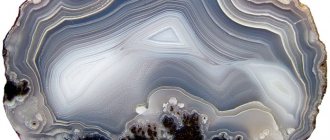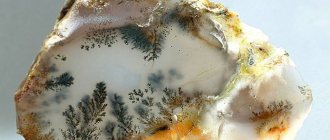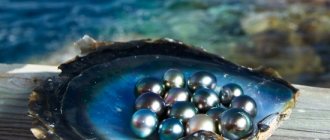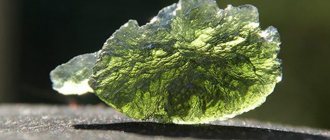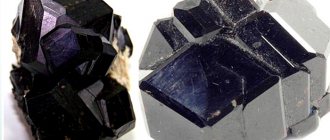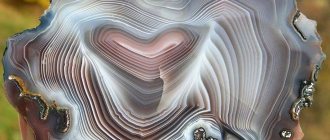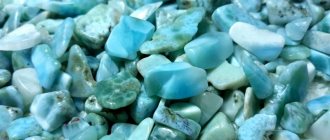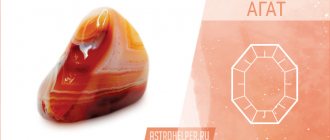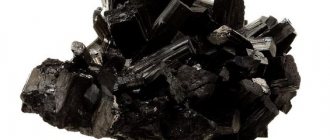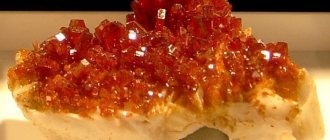We have all seen amber with inclusions - particles of flora and fauna that many centuries ago fell into resin and froze for thousands of thousands of years. We consider the ancient ant as if it had fallen into our hands from a strange, unknown world. What if we manage to find a stone that has been storing the feathers of six-winged angels for centuries? Or a stone that has preserved a frosted pattern since the Ice Age? It sounds like an artifact from a fantasy book or a new movie about wizards and dragons. But this stone - with feathers and intricate patterns - is not the invention of a science fiction writer.
An incredibly outlandish mineral, the description of which was first published at the end of the 19th century by the well-known scientist and part-time mineralogist N.I. Koksharov in his works, the stone is seraphinite or clinochlore. This mineral is considered unique for a reason, because it can only be mined in a single deposit in Siberia near the well-known Lake Baikal, and there are whole legends about the miraculous properties of the gem!
History of the stone where it is mined
For a long time, seraphinite remained unknown to most people.
Moreover, only a limited circle of specialists knew about this group of minerals, despite the fact that their study began about 150 years ago. One of the references can be found in the works of the American geologist W. Blake back in 1851. Then the scientist called crystals with similar qualities clinochlores. If we translate this term from Greek, the meaning is: “green on a cut or fracture.”
The Russian scientist N.I. Koksharov also studied the stones in 1888. In his works, he described minerals found in the Subpolar Urals.
Seraphinite is a stone that has been ignored for a long time, despite the fact that it is distinguished by its decorative properties. The situation changed significantly after the overall supply of semi-precious and other ornamental stones began to decline. After this, not only geological collectors, but also representatives of the jewelry industry paid attention to the stone.
Currently, minerals that are best suited for various kinds of crafts are found on the territory of the city of Zlatoust, and also in the Irkutsk region.
Initially, clinochlore was discovered in Kazakhstan, Turkey, Poland, America and Australia. A significant difference between these finds was that they were rather individual stones or even small inclusions.
The real deposits are located in Russia, or more precisely, in the Southern Urals. The initial discovery was associated with garnet and epidote mining. It is in this territory that a large number of unique and beautiful (from a jewelry point of view) seraphinite stones are found.
Only recently did jewelers pay attention to the stone
Story. Legend
The clinochlore stone was first described in the mid-19th century by the American scientist W. Blake.
He also gave the name to the mineral. Klino translated from Greek means “I tilt”, chloros means green. This name indicates the peculiarity of the arrangement of the crystals - they are inclined relative to each other at different angles. In addition to the official scientific name, the stone has other names, the most famous of which is seraphinite (this is the trade name of clinochlore; it is under the term “serafinite” that it is listed in jewelry store catalogs). In 1888, the properties of clinochlore found in the Urals were described in detail by Russian mineralogist N.I. Koksharov. However, then they did not pay much attention to this stone, and only a few years later it became in demand by collectors. It began to be used in jewelry only in the mid-20th century . It was then that clinochlore received the commercial name “seraphinite”.
A metamorphosis occurred with this name: in Russia, people called one of the most beautiful varieties of clinochlore seraphimite, since its patterns resemble the magnificent wings of angels (seraphim are angels of the highest rank with six wings). But in Europe this name was turned into seraphinite.
In Russia there is a legend about the origin of the stone. It says that seraphinite is the feathers from the wings of six-winged angels. Beautiful lush feathers fell to the ground and froze in stone.
Origin of the stone
Seraphinite in its origin is a hydrothermal product of the alteration of pyroxenes, biotites and amphiboles. It can form in chlorite schists, serpentinites, marbles, calc-silicate rocks, and amphibolites. Less common in igneous ultramafic rocks.
Also, the formation of clinochlore may be associated with ore-forming processes. The mineral can be associated with plagioclase, diopside, calcite and other minerals.
Legends
There is a beautiful legend about the appearance of seraphinite. It is believed that the angel Seraphim flew past the earth and dropped feathers from his wings. They turned into beautiful green stones.
There is another legend associated with Seraphim. The angel heard the story of the abandoned girl and cried because of the injustice in the world. Large tears turned into greenish crystals of enchanting beauty.
Description
Clinochlor is a transparent or translucent gem of green shades with a patterned surface and a glassy or greasy luster.
Intricate patterns are the main advantage of the mineral. This is due to the impurities of iron, manganese, aluminum in the composition of the mineral.
In addition to the classic green, there are specimens of yellow, pink, grayish, and lilac colors.
Features of the mineral
Clinochlor is a complex silicate, the appearance of which is determined by its composition. Due to its unique and complex crystal lattice structure, it is capable of absorbing various spectra. This is evidenced by the gray and golden reflections reflected from the mineral after the sun's rays hit it. Seraphinite contains silicate compounds of iron, aluminum and manganese.
| Property | Description |
| Hardness (Mohs scale) | No more than 2.5. |
| Density, g/cm3 | 3 |
| Transparency | Transparent, translucent. |
| Cleavage | Perfect |
| Shine | Glass, shimmering. |
| Solubility | Concentrated sulfuric acid |
| Kink | Uneven |
| singonia | Monoclinic |
A distinctive feature of clinochlore is its pattern. It is formed by silvery inclusions. Finding two stones with the same pattern is quite difficult. It can have floral motifs, look like scales or cobwebs. The gem is resistant to alkalis and is highly resistant to acids. Jewelers process the stone using the cabochon technique.
The color range varies from greenish-bluish to olive and dark green. Minerologists were able to classify seraphinites by composition into the following varieties:
- kochubeites - contain a large amount of chromium, can be purple, pinkish and lilac;
- corundumphyllites – iron predominates among the available components;
- sheridanites – saturated with aluminum;
- ripidolites - they do not contain enough iron;
- Leuchtenbergites are yellowish, often colorless minerals.
Physico-chemical characteristics of clinochlor
Clinochlor is a complex compound of magnesium, aluminum and silicon.
Its crystals are colored in shades of green, gray, yellow, brown, reddish, purple, blue and black, and are occasionally white. They are transparent or translucent, have a monoclinic system, perfect cleavage, uneven fracture and a rich pearlescent luster. — Advertising —
The hardness of clinochlore on the Mohs scale is 2-2.5. Density 2.6-3 g/cm3. The mineral is soluble in concentrated sulfate acid.
Clinochlore crystals are columnar, tabular in shape, often polyhedral or form double intergrowths. There are also intergrowths of scaly, leafy and radially leafy structures, both solid and powdery.
Minerals accompanying clinochlore include vesuvians, garnets, diopsides, calcites, magnetites, titanites, chondrodites, epidotes, quartz, dolomites, actinolites, biotite, olivine, plagioclase, and talc.
Description and external signs
At first glance, it is hard to believe that Seraphinite is a stone of Earthly origin. Its patterns, which resemble the wings of angels, are breathtaking. This is who is full of mysteries and secrets, about whom legends and beliefs are made. This gem is also popularly called clinochlore. Initially, no attention was paid to it, and it was not in demand among jewelers. At the end of the 19th century, products made of tourmaline, emerald and malachite were in fashion. But their deposits began to quickly dry up, so they began to think about using Seraphinite in jewelry.
The patterns on the stone are always different, it all depends on the imagination of the beholder. These can be winter drawings on glass, fern leaves, lovely feathers of birds, airy lace, fish scales and much more.
In ancient times, our ancestors would have worshiped him like an idol. It is solely due to such a variety of designs that this gem is so loved by artists - stone cutters and jewelry makers.
What does this mineral look like? Crystalline formations of black-green, light green, olive, green-bluish, gray-green shades with glassy, silky, greasy, dull, pearlescent luster, greenish-white, smoothly turning into white features.
Varieties that are pinkish or purple are rare, as well as white, grey-white and yellow. This color is influenced by the concentration of chromium oxide. As for transparency, nuggets are either translucent around the edges (mostly no transparency) or are able to transmit a small amount of sunlight.
Seraphinite is part of the chlorite group and belongs to the class of complex silicates. The structure of the mineral includes iron, aluminum and manganese. This stone is quite soft, so it is very resistant to mechanical damage that causes scratches. The size of the crystals can reach several tens of centimeters in diameter.
Difference from fake and compatibility
Seraphinite has a complex and unique pattern, which makes it very difficult to fake. Most often, they try to replace the stone with ordinary plastic. In addition, natural stone is distinguished by the following features:
- The weight of a fake will always be lighter.
- The color of this mineral is uneven and varied.
- When immersed in water, the fake loses its brightness and shine.
- The structure of a natural mineral is always heterogeneous; it contains chips and cracks.
As for compatibility with other stones, everything is quite ambiguous. In most cases, clinochlor does not tolerate proximity to other minerals, so it is preferable to use it separately. However, color also has a big impact. However, most experts recommend using it in jewelry on its own.
It is quite easy to distinguish a natural stone from a fake.
Physical and chemical properties of clinochlore
Clinochlore is a complex silicate. Its key physicochemical properties include:
- Hardness: 2-2.5 units on the Mohs scale;
- Color: shades of green;
- Gloss: greasy, glassy;
- Fracture: uneven;
- Pattern: White lines resembling crystals. The formula of the mineral is quite complex and long. It contains more than 30% MgO, 10% FeO, 15% Al2O3, etc. The stone dissolves in sulfuric acid.
Seraphinite deposits
It is very remarkable that such unique natural stones can be found exclusively in the vastness of Russia. The most significant deposit of these minerals is located in Siberia, in close proximity to Lake Baikal. There are no other places on the planet where these gems are mined.
This mineral is interesting because it has the ability to “grow” among arrays of other precious stones, such as chalcedony, moss agate, quartz, which gives the latter a certain charm and high aesthetics.
Seraphinite mining
Seraphinite is distinguished by its sedimentary or metamorphic origin. It is formed only in a few places on the planet:
- Switzerland;
- Ural, Baikal region;
- Spain;
- Japan;
- Madagascar, etc. The largest places of gem formation are recorded on Lake Baikal, in the Shishim Mountains, and in the southern Urals. Therefore, seraphinite is often called a Russian treasure.
Clinochlore deposits
The most famous deposit of clinochlore is located in the Akhmatovskaya mine (Nazyam Mountains).
Colorless specimens of high jewelry quality were found here. — Advertising —
Clinochlore deposits are also known in the USA, Madagascar and Poland.
Varieties and colors
Seraphinite has a large number of varieties:
- Chromium or kochubeite has a pink-lilac or violet hue. The reason for the appearance of this particular shade is the chromium impurities contained in the composition.
- Nickel has a greenish “bottle” color.
- Corundophyllite - contains iron, dark gray in color.
- Leuchtenbergite is colorless.
- Pennine is green.
- Sheridanite is enriched with aluminum and has a grey-green color.
Different colors of mineral
Kochubeit
Geologists have identified several varieties of seraphinite.
Kochubeite contains 4-11% chlorine. The stone was named in honor of Pyotr Kochubey, a famous Russian scientist. Kochubeite deposits are located in the Middle Urals in the Karkadinsky mine.
Due to the admixture of chlorine, the color is uncharacteristic for seraphinite - lilac-green.
Shades depend on lighting. In a room with fluorescent lamps, seraphinite plays with lilac tones. Under the sun's rays - greenish.
There are also samples of purple and soft pink.
Kemmererite
Kemmererite also has a high chromium content. Its color is deep purple. The stone was named in memory of the mining engineer Alexander Kemmerer.
Sheridanite
Another variety of seraphinite with a predominance of aluminum. The stone was named after the city of Sheridan (USA), where it was discovered. Sheridite has grayish tints.
Leuchtenbergite
Iron content is minimal. Therefore, the stone is light green in color with a yellow undertone. Geologists also found white samples.
The mineral was named in memory of the 19th century mining engineer Maximilian of Leuchtenberg.
Nickel clinochlore
The mineral contains nickel impurities. The color is greyish.
Types of clinochlore
- Chromium clinochlore - contains chromium, due to which it is colored in shades of pink or purple. Also known as kochubeit.
- Nickel clinochlore is distinguished by the content of nickel in its composition.
- Corundumphyllites – contain iron compounds.
- Rhipidolites are also distinguished by the admixture of iron, but in small quantities; the colorless subtype is called leuchtenbergite.
- Pennines are a type of clinochlore with a pseudo-trigonal structure.
- Sheridanites are enriched with aluminum and are mined in the USA.
- Seraphinite is a common trade name for clinochlore, which contains characteristic iridescent fibers called “feathers.”
Application area
The stone has natural beauty and an unusual structure, which is why it is highly valued by jewelry craftsmen and mineral processing specialists. Since seraphinite is mined in small quantities, figurines, boxes, rosaries and other small items are made from it. Jewelers most often set the mineral in silver. Clinochlor looks great in items such as rings, brooches, beads, pendants, earrings and bracelets.
In addition to practical use, this ornamental stone is known for its healing properties. It is also often used in practical magic by esotericists, shamans, magicians and psychics.
Collecting
The owners of mineralogical collections were the first to notice the stone with an unusual pattern.
Combined specimens with a base made of precious stone are valued. Seraphinite intersects their thickness with scaly veins-twigs. Moss agate, chalcedony, and landscape quartz are good “companions” of seraphinite.
Specimens of Russian stone are represented in all major personal, corporate and private collections of minerals.
Decor
Master stone-cutters create animal figurines, other small plastic items, boxes, and tableware from seraphinite. That is, things whose purpose is to please the eye, and not to perform utilitarian functions.
Products from Seraphinite
Jewelry
Almost zero hardness and fragility raised doubts about seraphinite as a jewelry material. The gem began to be positioned on this market less than half a century ago:
- The stone is processed into a cabochon, choosing a shape that best reflects the uniqueness of the pattern. This is not always the right figure; asymmetry is even better.
- It becomes an insert for earrings, brooches, pendants, necklaces, and pendants.
- Rings, signet rings, and bracelets are almost never made from seraphinite. After all, these products experience loads that can quickly destroy a pebble.
Seraphinite jewelry The best setting in jewelry is openwork silver; upon request, the stone is framed in white gold or platinum.
Price
Despite its uniqueness and rarity, clinochlore is not very expensive.
The cost of the stone depends on the following factors:
- size;
- structure;
- color saturation;
- quality of processing.
The paler and lighter the color of the stone, the cheaper it is.
Seraphinite products are offered on the Russian market: handmade figurines, collection material, jewelry:
- tumbling (2–3 cm) — $ 10;
- samples (15–30 cm) — $ 340–560;
- animal figurine (7–8 cm) — $ 80–100;
- half-meter thread of seraphinite tumbling beads - $10–50 depending on the quality of the stone;
- bracelets and beads made of polished seraphinite of a given shape - $ 40–200.
Products in a silver-plated frame or made of nickel silver have the following prices:
- brooch - $ 15–35;
- ring - $ 20–50;
- earrings - $ 20–80;
- pendant - $ 30–50.
Seraphinite goes well with silver, but those set in silver are more expensive, for example, the price of rosary beads or rings starts from $95 .
Read also: Staurolite - a stone of happiness and good luck for selfless people
How to wear
The patterned but discreet range of the stone makes jewelry with it universal:
- They can be worn by people of both sexes and different ages. The younger the owner, the lighter the stone. For example, pink-hued seraphinite in a pendant or stud earrings is suitable for a young lady. A more mature lady will be adorned with massive items with purple or greenish accents.
- A silver two-piece set is appropriate for the office: earrings plus a ring, earrings and a pendant, or a pendant and a ring.
- Men's accessories - cufflinks, tie clip, ring with a dark stone.
Each product is unique due to its pattern. If there is no suitable option on sale, you can buy material for needlework. For example, natural beads, from which it is easy to create a bracelet for the upper third of the hand or a bauble.
Stone jewelry
Seraphinite is used in the manufacture of jewelry or decorative crafts (boxes, figurines). Asymmetrical stones in combination with silver or white gold look best in jewelry.
The gem does not attract too much attention, so it easily matches any style of clothing.
The most successful combinations:
- a bright linen sundress and a massive bracelet;
- an office suit made of natural fabrics and a ring or earrings;
- a simple white T-shirt, jeans, sneakers and a pendant on a long thin chain or massive earrings;
- Cufflinks or tie clips made from a gemstone or rosary will look good in a man's wardrobe.
View this post on Instagram
Posted by Natural Stones and Fittings (@omsalons) Jul 27, 2019 at 10:48 am PDT
Caring for stone and products made from it
Seraphinite is easy to scratch and damage. It should be stored in a separate box, away from sunlight.
The gem is fragile, so it should not be cleaned with steam, ultrasound, or a stone cleaner. It is better to use a soap solution and a microfiber cloth.
View this post on Instagram
Posted by Elena Potsepnya (@elenapotsepnia) July 19, 2022 at 4:08 am PDT
Medicinal properties of clinochlor
Clinochlor is a healing stone. This became known decades ago, and modern lithotherapists agree with this opinion. The healing properties of the stone were revealed through research and observation.
Seraphinite contains some minerals, so wearing it strengthens bones and improves skin. If jewelry with a gem is not removed for a long time, the damage to the skin will heal much faster, and there will be no traces left on the skin.
Since the stone improves the skin, it can be worn to prolong youth. Lithotherapists believe that the gem retains collagen inside the epidermis. Thanks to this, the skin remains firm and elastic for many years.
Clinochlor strengthens the cardiovascular system. It is recommended to wear it to prevent diseases such as tachycardia, arrhythmia, myocardial infarction, stroke and others.
Seraphinite is a good anti-stress. If you look at the pattern on the stone every day, you can get out of depression, calm your nerves, and get rid of stress and insomnia.
The stone relieves headaches. To get rid of them, you need to apply the gem to your temples, the frontal or back of the head is ready at those moments when a problem arises. The gem stabilizes blood pressure. Wearing it is useful for both people with hypertension and hypotension.
Clinochlor protects against colds and helps get rid of ailments such as sore throat, acute respiratory infections, flu and others.
The gem promotes the resorption of all types of tumors. This applies to benign and malignant formations.
Healing, rejuvenation
This stone has irresistible healing properties for women and some men, it rejuvenates. This is noticeable not only on the skin. Clinochlor accelerates tissue regeneration and strengthens the immune system.
Take a stone and just admire it, the way you admired the clouds, the wings of a butterfly, or the flight of a dragonfly as a child. This simple daily activity will help fight depression and lift your spirits.
Cost of jewelry
The price of gem jewelry is low: for example, a pendant costs from 1000 rubles, a ring – from 4000 rubles, earrings – from 3500 rubles, beads – from 2000 rubles, cufflinks – from 2500 rubles. The lighter the mineral, the cheaper it is.
Seraphinite is a stone that reveals the good aspects of its owner: kindness, compassion, loyalty, and brings harmony and well-being to the home. People who have gem jewelry are protected from bad influences and evil thoughts.
Would you like to have jewelry with seraphinite? Leave your opinions in the comments and repost so that more people know about the angel stone.
Magical properties of seraphinite
Seraphinite also has magical properties. Among esotericists there are also those who consider clinochlor an angelic stone. The energetic power of a gem can change a person’s character and get rid of such negative aspects as anger, callousness, envy, greed and others.
The stone also enhances the positive aspects of character. It makes a person merciful, compassionate, kind and sympathetic. The stone's influence on character formation makes it a useful gem for children.
Clinochlor is recommended to be worn by people whose professions are aimed at changing the world for the better, as well as educating the younger generation. Among them are teachers, doctors, volunteers, philanthropists, public figures, and so on.
Seraphinite is considered by esotericists to be one of the most powerful amulets for the home. Products made from this stone, placed in the home, will preserve the idyll in the family. They will also protect the house from natural disasters - earthquakes, floods, landslides and others.
The gem drives away misfortunes from the home, as well as illnesses from its inhabitants. The stone improves the financial situation of family members. It also protects against negative magical effects.
Seraphinite will help a person develop spiritually and intellectually. If you wear a stone during meditation, you can quickly reach the desired relaxed state and even visit other worlds during this process. For these purposes, only dedicated people can use the gem.
These are the basic meanings of the gem.
Light magic
The magic of the gem rejects dark forces and thoughts.
The mineral has a strong influence on the emotional sphere of the owner. The energy of seraphinite sets one in a positive mood and ennobles the thoughts and actions of the owner of the stone.
Seraphinite - “altruist”. His support is needed by people who bring kindness, the light of teaching, and help into the world. This:
- rescuers;
- teachers;
- clergy;
- doctors.
The magical properties of seraphinite help yoga fans in meditation.
Interesting: there is an opinion that using a gem to enter a trance will attract the support of the angel of the owner of the stone.
Esotericists are confident that seraphinite souvenirs will become guardians of the home and family hearth. The stone will help establish peace, harmony, and prosperity in the house.
Where to find angel feathers
For the first time, clinochlore deposits were discovered in Russia (we are proud of the riches of our state). The mineral can be mined in the Subpolar and Middle Urals, in the Irkutsk region. It was believed that clinochlores exist only in our country.
But time passed, and now seraphinite is mined in countries:
- Austria;
- USA;
- Türkiye;
- Scotland;
- Greece.
Obviously, there are more deposits. It’s just that exploration for clinochlore was not carried out.
The origin of the mineral seraphinite comes from igneous and metamorphic rocks. Mining is often confined to chlorite shales.
Talismans and amulets made of clinochlore
Seraphinite can be used as a full-fledged amulet. This mineral fights best with:
- bad intentions of others;
- damage;
- evil eyes;
- negative influence of strangers.
In addition to protection, the stone promotes internal opening. For some, it helps develop psychic abilities. For others, to understand themselves, their true desires and goals.
Where is it mined and how is it processed?
Seraphinites are widespread in nature, mainly in rocks and sedimentary iron ore deposits. The main deposits of the mineral are located in Russia (Akhmatovskaya mine, in the Chelyabinsk, Irkutsk, Sverdlovsk regions), Switzerland, Austria, Scotland, Greece, Japan, USA, Korea.
Seraphinite is mined by open-pit mining using manual labor.
Seraphinite is a porous mineral, so before processing it requires preliminary sizing with special substances, and sometimes a substrate. During the processing process, you have to constantly monitor the shape due to rapid grinding, and polishing is performed with a thin diamond paste.
Properties of seraphinite for women and men
Some properties of clinochlor for men and women differ.
For example, this stone allows representatives of the fair sex to prolong their youth. It slows down the process of skin aging and decline in morale. It also has a beneficial effect on the charm of its owner: surrounding men will look at you with great interest.
For representatives of the stronger sex, seraphinite is an assistant in building a high status. The stone will help a man gain authority in society and earn the trust of others.
Price
According to the jewelry classification, clinochlore is considered semi-precious or ornamental. Anyone can buy jewelry, collection material, prices are affordable (thousand rubles):
- bracelet – 0.9 – 4.5;
- pendant – 1.5 – 2;
- earrings – 1.5 – 5.5.
The cost of the stone is influenced by the density of color and dimensions, and in the products - the material of the frame.
Who is Seraphinite suitable for according to their zodiac sign?
Astrologers do not recommend wearing gems to everyone based on simple sympathy for the stone. They are sure that any gem has strong energy, which has a different effect on one or another zodiac sign. There are only some stones that are universal amulets. They suit every zodiac sign. Seraphinite also belongs to them.
There are only two zodiac signs with which the gem is ideally compatible. It also suits the rest of the zodiac signs.
Seraphinite compatibility with zodiac sign. Table 1.
| Zodiac sign | Compatibility (“+++” – fits perfectly, “+” – can be worn, “-” – strictly contraindicated) |
| Aries | + |
| Taurus | + |
| Twins | + |
| Cancer | + |
| a lion | + |
| Virgo | +++ |
| Scales | + |
| Scorpion | + |
| Sagittarius | + |
| Capricorn | +++ |
| Aquarius | + |
| Fish | + |
Thanks to the gem, Virgos will become easier to communicate with. Their eternal pickiness about everything will disappear. This will help Virgo improve relationships with loved ones, friends and colleagues.
Seraphinite stone helps Capricorns gain ease of communication. He saves them from suspiciousness and anger.
Seraphinite will help Taurus to pay attention to the fact that in this life there are not only material, but also spiritual values. Thanks to this gem, people of this sign begin to strive for self-improvement and intellectual growth. It happens that this contributes to career growth.
For Aquarius, Libra and Gemini, the stone will help them look at life realistically. Seraphinite will also make people of these signs more constant in their relationships, work and even passions. For example, the gem will help Aquarius to start a permanent relationship. The stone can push Aquarius to get married if it feels that there is a pure and sincere feeling between the lovers.
For Sagittarius, Aries and Leo, the gem will help get rid of ardor and anger. He will make people of these signs become kinder and more merciful. After this, they can feel how easier their communication with people around them has become.
For Cancers, Scorpios and Pisces, the gem will help cleanse the energy. This will have a positive effect on the state of their karma. This means their entire life will improve.
Seraphinite is a universal gem that has no contraindications. The only drawback of clinochlore is that it requires careful handling and special care, because any damage to it will lead to the appearance of cracks on the surface of the stone.
Therapeutic effect
Lithotherapists have found that wearing products with clinochlore is useful in the following cases:
- Restoring the body after illness or surgery.
- Healing wounds, cuts.
- Preserving youthful skin.
- Strengthening the immune system.
Earrings with clinochlor help overcome hypertension, migraines, and headaches.
Yogis advise contemplating the patterns of the stone during meditation or if you need to calm down.
It is believed that clinochlor inhibits cancer.
Proper mineral care
Seraphinite is not a highly durable stone. When storing the stone, remember that it is quite fragile and should be stored separately from other minerals. To avoid scratching the gemstone, it should only be wiped with a soft, lint-free cloth. When cleaning, certain conditions must be observed, as this will ensure its long and reliable service. Never use ultrasound or steam.
Clean the bead only with a soft cloth dampened in warm, soapy water. If you are unsure whether you can clean a piece yourself, you can take it to a jewelry store for cleaning. Seraphinite will become a friend, helper and protector for everyone who acquires it and takes care of it. If properly stored and cleaned, this stone will last for many years.
How to care
Since clinochlor is fragile, it requires careful handling and care:
- Store the stone wrapped in soft cloth and placed in a box.
- Jewelry should be removed before doing housework, going to the gym, or swimming pool.
- Protect from scratches, impacts, falls.
- Clean with a cloth soaked in a mild soap solution.
- When cleaning the frame with a special product, make sure that it does not get on the insert.
- Do not immerse the pebble in water for a long time.
- It should be dried in the shade.
Cleaning with abrasive, steam, or ultrasound is strictly prohibited.
How to distinguish a real stone from a fake
The stone is quite rare and inexpensive, so it is not often counterfeited.
The natural mineral is characterized by a special pattern that resembles wings with a lot of feathers, frozen glass, thin lace or fern leaves. There is never such a pattern on fakes.
IMPORTANT! Natural seraphinite is soft. Counterfeits are usually made from polymer, which is much harder.
The mineral is also often used to imitate jade.
Clinochlor colors
The main color for clinochlore is green. Opaque specimens are usually greenish-blue in color. What gives the gem its unusualness and beauty are inclusions with a fibrous structure, which are woven into it into elaborate patterns, the finest meshes and shining rays. These stones look really amazing.
Interesting facts about clinochlore
Kochubeit
- Clinochlor makes its owner better, reveals all the positive qualities, therefore the stone is recommended as a talisman to doctors, teachers, priests, healers, and public figures.
- Clinochlore figurines and figurines serve as excellent home amulets. They make the house warm and cozy, and endow the owners with prosperity and abundance. A woman who chooses clinochlore as a talisman will definitely become an excellent housewife.
- Another name for the gemstone, seraphinite, is associated with an ancient beautiful legend. They tell how the angel from Heaven Seraphim, the owner of six wings that shone with a bright extraordinary light, saw how a good girl was being offended by an evil man. Since he had no right to interfere in people’s lives, the angel cried, feeling sorry for the girl and from his own inability to come to her aid, and he reached the ground and turned into amazing emerald-colored crystals. So clinochlore received the name seraphinite or tear or angel stone.
Sources
- https://mistymag.ru/serafinit-kamen/
- https://ogems.ru/dragotsennye/klinohlor-ili-serafinit
- https://kamniinfo.ru/opisanie/serafinit-kamen-svoystva-i-komu-podhodit-po-znaku-zodiaka-serafinit-opisanie-kamnya-s-foto-ego-magicheskie-svoystva-i-znachenie-dlya- cheloveka.html
- https://kamushki.info/prirodnye-kamni/serafinit
- https://kamneteka.com/kamen-serafinit-svoystva-znachenie-i-vliyanie-na-raznyie-znaki-zodiaka/
- https://samotsvet.ru/enciklopedia/serafinit-svoystva-i-komu-podkhodit.html
- https://MoyKamen.com/vidy/podelochnye/serafinit-kamen.html
- https://stone-stream.ru/dragocennye/klinohlor-kamen.html
- https://potustoronnee.com/kamni/serafinit.html
- https://luludmila.ru/serafinit-kamen-svoystva/
- https://planeta-mineral.ru/zvezdy/serafinit-kamen-svojstva.html
[collapse]
Mineral of the ornamental group Seraphinite: properties and magic
Seraphinite
Seraphinites , also known as clinochlores, are considered rare stones, used only for collection or ornamental purposes. Their popular name reflects the appearance of the mineral. Once formed, it seems to be overgrown with patterns of feathers reminiscent of the wings of angels. Therefore, such a divine name gives the mineral a bit of religious overtones. For many epochs, Seraphinites served as raw materials for the manufacture of religious paraphernalia and were a symbol of churchliness.
Today, few places are actively searching for the crystal. It is distributed in most cases in Russia, the Urals, and Siberia. But gemologists claim that as soon as the stone becomes more popular, which is already a trend, its deposits will begin to be purposefully searched for in other parts of the planet.
Appearance
Seraphinites are complex silicates that do not have high hardness. More precisely, they don’t have it at all. Their Mohs hardness is around 2-2.5, which makes the stone very soft. Therefore, if a mineral is used in jewelry, it is usually something simple, in the form of an oval, cabochon, or circle.
The structure of the stone is somewhat similar to charoite. Fibers inside the mineral absorb light rays in different directions and convert them into reflected light, which forms patterns resembling feathers. They are usually silvery or golden in color, sometimes greenish. The base of the mineral itself is green, spruce, but sometimes chromium oxides can change color to purple or pink.
Possessing opacity, the stone tends to have more decorative properties. Occasionally it can show through in its plates. The luster of the mineral is glassy, sometimes pearlescent at the fracture.
Treatment
Seraphinites are extremely soft, therefore no complex processing or cutting is carried out with them. They can be cut, even used in sculptural cutting, ground, and polished. Often they are given ordinary shapes in the form of a cabochon, if we are talking about collectible stones or used as an insert in jewelry. But this happens infrequently, the mineral is not very common.
No refining parameters are carried out with the stone. The seraphinite mineral is beautiful from birth, and any improvement processes can only spoil its appearance. It usually comes with an “N” mark, which means “unprocessed.”
Application
Being easy to cut, gems can be used in crafts as excellent raw materials for plastic cutting. They can be used to make beautiful carved brooches and pendants, cameos, various crafts and souvenirs, figurines, boxes, and flowerpots. This is a good stone for making decor, but it is not used so often in this area. In earlier times, clinochlore often figured in the creation of religious paraphernalia.
Seraphinite is also considered an excellent material for the manufacture of inexpensive imitations of jade, since they are sometimes similar in appearance, but what distinguishes them is their hardness.
Stone is also used in jewelry applications. Here it is used less often, usually in simple jewelry that does not require complex cutting of the mineral. Decorated in a cabochon, seraphinite is inserted into simple and sophisticated products, protected by special frames.
Collectible use is another area for clinochlore where it can be appreciated and sold at a very high price.
Magic properties
Due to the appearance of the stone, it was often ranked among the divine messengers who are endowed with a holy essence and can bring a person closer to higher powers. Looking like the wings of angels, the mineral became a symbol of religiosity, holiness, light and goodness. Therefore, it was believed that it was precisely these abilities that he helped to cultivate in a person. It was advised to wear it to protect against evil forces, from temptations and to give strength to the spirit.
Seraphinite stones help almost everyone, they especially favor Virgos and Capricorns. Also under the tutelage of holy protection are people of noble professions - doctors, teachers, priests. You can hope for the help of the stone in different life situations; seraphinite can help always and everywhere, it is incredibly generous and kind.
Medicinal properties
In therapeutic terms, clinochlor also helps in many areas. It is used to strengthen the immune system, to increase the regeneration of tissues, bones, and internal organs. That is, the stone seems to heal the human body on many fronts. Thus, it helps to fight even complex diseases, and works well in the treatment of colds, heart and vascular diseases.
Clinochlore patterns are beautiful and, when viewed, can achieve calmness, balance of mind and emotions. With the help of seraphinite, neurological and psychological diseases can be treated. The stone helps to calm down, reduce the level of aggression, get rid of insomnia and nervousness. This is a good helper for depression, panic attacks, and hysterical situations. It will also be useful in massage to relieve muscle pain and tension. Lithotherapists recommend this mineral for stuttering, tics, and other manifestations of neurological diseases.
Fakes
The stone is considered not too common and expensive, so it is rarely counterfeited, much less imitated in the laboratory. But occasionally you may come across handicraft fakes made from plastic or acrylic. In these cases, you can distinguish a real stone by the following parameters:
- Weigh the real mineral and the fake in different hands. The original should feel heavier than plastic.
- No two clinochlore patterns are the same, all stones are unique. Therefore, in a paired product, you need to check the appearance of the stone. Its color will be uneven and non-repeating.
- It is worth holding the seraphinite in one hand for a minute, then touching it with the other hand. If it remains cool to the touch, then it is real.
- Perfect specimens of clinochlore are rarely found; they may contain unevenness, chips, and cracks. A too ideal surface indicates the artificial origin of the product.
Counterfeiting of jades by seraphinite is considered a common occurrence. In this case, they can be distinguished by hardness, since jade is similar in this parameter to glass, and clinochlore has very low hardness, even softness.
Interesting Facts
- Seraphinites are not only soft, but also unstable to vapor and ultraviolet radiation. Therefore, their cleaning should be carried out by a professional.
- It is best to view the stone in daylight, as its beauty and radiance are more pronounced. The patterns acquire that same silvery or golden glow that is the calling card of the mineral.
- In former times, not only jade, but also tourmaline, malachite, and emerald were counterfeited with clinochlore.
- Today, the stone is mined only in Russia, usually in the Lake Baikal region and in Siberia.
Care
Seraphinites are soft and easily scratched and damaged. They must be stored separately from other stones and objects, and immediately buy a bag or box for the product. It is advisable to wash the jewelry with special products or seek help from a specialist. As a last resort, you can use delicate soap and a soft cloth. The stone is afraid of rough influences, temperature changes, and direct sunlight. It must be worn carefully and stored carefully.
Mineral deposits
Calcite is widespread, deposits are found in many regions and countries. The volume of its occurrence is difficult to overestimate. The mountain ranges of the Alps and Cordillera consist entirely of it. The largest minerals are mined in Iceland, where samples up to six meters long are found. Large deposits are located in Mexico and Central Asia.
In Russia, production is carried out in Siberia, Transbaikalia, the Republic of Karelia, and the Kola Peninsula. The Ural Mountains, Primorye and the Leningrad region are rich in the mineral.
The wide distribution of Iceland spar does not allow us to list all the deposits, of which a large number are being developed; many calcite mines are located throughout the world.
Aesthetic value and application of seraphinite
An amazing crystalline pattern with mother-of-pearl tints, reminiscent of the wings of angels, gave such a poetic name to a rare mineral found only in the Baikal region. The more picturesque the patterns inside the stone, the higher its aesthetic value. But its other qualities are no less surprising, and clean energy has been appreciated relatively recently.
The iridescence, reminiscent of the feathers of angel wings, is more pronounced, and there are simply iridescent veins, reminiscent of crumpled foil inside a greenish crystal. Large green crystals radiating rays are extremely rare, therefore they are most in demand among collectors and lovers of jewelry with green stones. Each sample is capable of changing shade, depending on how the light falls on the ray-shaped crystals.

